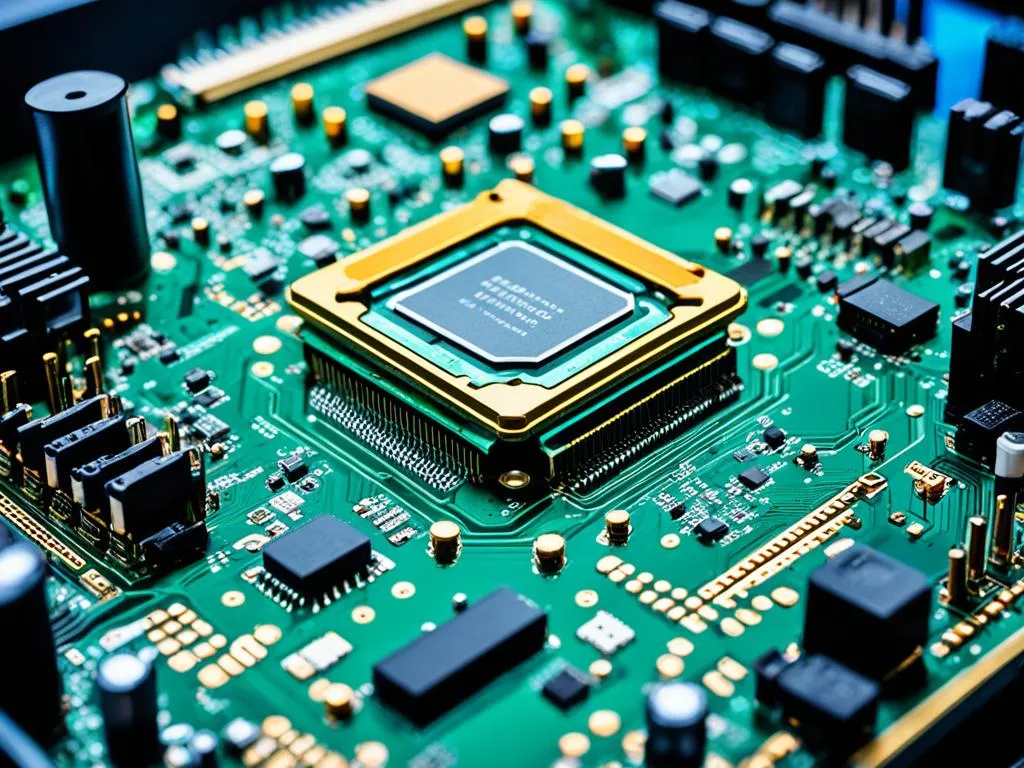Keeping your motherboard drivers up-to-date is key for smooth computer operation. They are software that bridges the gap between your operating system and the motherboard. This guide will lead you through updating these drivers on Windows 11 or 10, using both manual and automatic ways.
Updating drivers helps avoid issues like system crashes and boosts security. This guide is for anyone, whether you’re good with tech or just starting. You’ll learn how to keep your system running perfectly.
Table of Contents
ToggleWhat is a Motherboard and its Drivers?
Every computer has a vital part at its core – the motherboard. This main circuit board links the CPU, memory, and storage. It’s like the computer’s central nervous system, managing connections and data transfer.
A Motherboard’s Role in the Computer System
The motherboard makes sure all computer parts work together. It’s the heart of the system. Without it, your computer can’t function properly.
Different Types of Motherboard Drivers
- USB Driver: Ensures the proper functioning of USB ports on the computer.
- Audio/Sound Driver: Helps the operating system communicate with audio devices.
- VGA/GPU Driver: Acts as a bridge between the motherboard and display devices.
- Storage Driver: Facilitates communication between the motherboard and storage devices.
- Network Driver: Enables the computer to connect to a network.
Motherboard drivers are key for your system to work with its parts. Updating them keeps your computer running smoothly and error-free.
Why is it Important to Update Motherboard Drivers?
It’s important to keep your motherboard drivers up-to-date. This ensures your computer runs smoothly and without errors. If your drivers are old or don’t match your hardware, you might see your computer freeze, get blue screens, or crash.
Updating your drivers prevents these problems. It keeps your computer stable and compatible with new software and hardware.
Prevents Compatibility Issues and System Crashes
Old motherboard drivers cause issues by not letting parts of your computer talk properly. This can lead to your computer freezing, showing blue screens, or even crashing completely.
By updating, you fix these issues. This makes your computer work reliably without sudden problems.
Enhances System Performance and Security
New motherboard drivers can make your system faster and safer. They unlock better performance from your hardware and make your system run smoother.
They also close holes that hackers could use to attack your computer. This keeps your personal data safe.
| Benefit | Description |
|---|---|
| Compatibility | Ensures your motherboard and other hardware components work seamlessly together, preventing conflicts and crashes. |
| Performance | Unlocks the full potential of your hardware, leading to faster system responsiveness and improved efficiency. |
| Security | Patches vulnerabilities and protects your computer against potential threats, safeguarding your data and privacy. |
Updating your motherboard drivers gives you a computer that’s more reliable, secure, and faster. This helps you enjoy using your computer for everything you do, like working, gaming, and exploring online, with peace of mind.
How to Find Your Motherboard Model and Manufacturer
Finding your motherboard’s make and model is the first step to update its drivers. It’s key for a smooth update. Luckily, it’s not hard to do. There are a few steps you can take to get this info easily.
- Access the System Information Tool: On a Windows computer, open the System Information tool. Press the Windows key + R, type “msinfo32” in the box, then hit Enter. This tool will show you various details about your computer, including the motherboard.
- Check the Motherboard Manufacturer and Model: In the System Information tool, you’ll find the “Baseboard Manufacturer” and “Baseboard Product” fields. These will tell you the motherboard’s manufacturer and model.
- Verify the Details on the Physical Motherboard: For extra confirmation, look at the motherboard inside your PC. You’ll see the manufacturer and model numbers printed on it.
Now that you know your motherboard’s make and model, you can move on to updating the drivers. You can get the updated drivers from the manufacturer’s website. Or, use a driver update tool to make this step easier.
| Manufacturer | Model | Chipset | Form Factor |
|---|---|---|---|
| ASUS | Prime B550-PLUS | AMD B550 | ATX |
| MSI | MPG Z490 GAMING PLUS | Intel Z490 | ATX |
| Gigabyte | Z690 AORUS ELITE AX | Intel Z690 | ATX |
Manually Update Motherboard Drivers from Manufacturer’s Website
To manually update the motherboard drivers, follow these steps:
- Identify your motherboard model and manufacturer. You can usually find this info in your computer’s BIOS or on the motherboard’s label.
- Go to the manufacturer’s website and look for the support or downloads section.
- Find the driver update section and select the right drivers for your motherboard model.
- Download the latest drivers that are compatible with your operating system and motherboard.
- Install the updated drivers by running the installation file and following the on-screen instructions.
- After installing, restart your computer to make sure the new drivers work correctly.
Updating your motherboard drivers from the manufacturer’s website is reliable. It ensures you have the newest and best drivers for your system. This process might need a bit of tech know-how, but it’s usually not too hard. It can fix problems with how your hardware and software work together.
Tips for Successful Manual Driver Updates
- Always read any instructions or notes from the manufacturer. This helps make installing smooth.
- Back up your data before updating any drivers. This will help in case something goes wrong.
- Make sure your computer has a good internet connection and enough space to store the new drivers.
- If you see errors or have trouble installing, check the manufacturer’s help pages or get support from a tech expert.
Follow these steps and advice to update your motherboard drivers easily. Doing this can make your computer run better and more smoothly.
Update Motherboard Drivers Using Windows Update
Windows Update can help update your motherboard drivers. Yet, these drivers might not be as new as those from the maker’s site. Here’s how to use Windows Update for this:
- Open the Start menu and search for “Windows Update settings”.
- Click on “Check for updates” to see if any new driver updates are available.
- If there are driver updates for your motherboard, Windows will get and install them for you.
- After the update, restart your computer. This makes sure the new drivers work correctly.
Remember, Windows Update is handy for driver updates. But, the drivers it gets may not always be the newest or the best fit for your system. For the latest drivers that work perfectly with your hardware, go straight to the manufacturer’s website.
Using Windows Update for motherboard driver updates keeps your system running well. Even if it’s not the latest, it’s a solid choice. It saves you from the bother of looking for and installing drivers on your own.
how to update the motherboard drivers Automatically Using Driver Update Software
Looking for and installing motherboard driver updates on your own takes a lot of time. But, there’s a better way. Tools like Advanced Driver Updater make updating easy. They keep your motherboard drivers current without the hassle.
Benefits of Using Driver Update Utilities
Driver update software is better than doing it manually. Here’s why:
- It finds outdated drivers on your system automatically.
- You get the latest drivers that work with your hardware.
- No more searching or downloading updates by hand.
- Keeps your drivers current, which makes your system work better.
- Saves you time and makes updates easier than before.
Steps to Update Drivers with Advanced Driver Updater
To update your motherboard drivers, use Advanced Driver Updater. Here are the steps:
- First, download and install Advanced Driver Updater on your computer.
- Then, open the program and start a scan by pressing the “Scan” button.
- Check the scan results to see any old motherboard drivers.
- Choose the drivers you want to update and click “Update”.
- The software will do the rest, installing the newest drivers for you.
Advanced Driver Updater makes keeping your drivers fresh simple. It scans your computer for outdated drivers. Then, it finds and installs the latest ones. You won’t need to search for updates yourself.
Just follow the steps above to use Advanced Driver Updater. It will make managing your drivers hassle-free and effective.
Troubleshooting Common Issues
If you have problems with updating motherboard drivers, like issues with new software or the computer acting strange, try these tips:
- Make sure the new drivers work with your computer’s model. Go to the manufacturer’s website to double-check.
- Start fresh with the new drivers. First, remove the old ones to avoid any clashes during the update.
- Look out for BIOS updates for your motherboard. Sometimes, updating the base software can fix driver problems.
- If things get worse after the update – like your computer crashing – go back to the last driver version to see if it’s the new ones causing the problem.
- Check that your computer can actually handle the new drivers. If it’s too old or doesn’t match up, problems can pop up.
- Do a scan for viruses or malware. These sneaky software foes can mess with driver updates.
If these steps don’t fix things, it might be time to call in the experts. The motherboard manufacturer’s tech support or a computer pro might have the answers you need.
| Issue | Possible Cause | Troubleshooting Step |
|---|---|---|
| Compatibility problems | Drivers not designed for your motherboard | Verify compatibility with manufacturer’s website |
| System crashes or instability | Conflicts with old drivers or BIOS issues | Perform a clean driver installation and check for BIOS updates |
| Hardware incompatibility | System doesn’t meet minimum requirements | Ensure hardware compatibility with driver specifications |
| Malware interference | Viruses or malware affecting driver installation | Run a system scan and remove any detected threats |
Follow these steps to tackle and solve motherboard driver update issues. Always focus on making sure your system is safe and compatible when updating important software.
Best Practices for Maintaining Updated Drivers
To keep your motherboard and other device drivers up-to-date, consider these best practices:
- Regularly check for driver updates from the manufacturer’s website. This ensures you have the latest drivers, which can improve system performance, fix bugs, and enhance security.
- Enable Windows Update or use a reliable driver update software to automatically scan and install the latest drivers. This saves time and ensures your system is always running the most current drivers.
- Back up your drivers before updating. This way, you can easily restore them if an update causes any compatibility issues or system instability.
- Avoid downloading drivers from third-party websites, as they may contain malware or outdated versions. Stick to reputable sources like the manufacturer’s official website or Windows Update.
- Keep a record of your motherboard model and manufacturer. This information will help you quickly find and download the correct drivers when needed.
By following these best practices, your motherboard and device drivers will always be up-to-date. This boosts your computer’s performance and stability.

Regular driver updates are key to a healthy, efficient computer system. They ensure a smoother, more reliable computing experience. Plus, they help prevent compatibility issues and system crashes.
Conclusion
It’s important to update your motherboard drivers for a stable, fast, and safe computer. This guide shows how to update them, both manually and automatically. Keeping your drivers in check with a good update tool will make your system run better and avoid problems.
Always back up your data before you update drivers or software. Being on top of driver updates is key to keeping your computer reliable and fast. This article has given you the knowledge and tools to manage motherboard drivers and maintain peak system performance.
Updating your motherboard drivers is a key step for a secure and efficient PC. With this guide, updating drivers can be done easily, either by hand or with special tools. Regular driver checks and updates protect your computer from issues and crashes. Always back up your data before you change drivers or software. Safety first, always. Keep your system running smoothly by following these tips.
FAQ
What is a motherboard and its drivers?
A motherboard is like the heart of a computer. It connects the CPU, memory, and storage. This connection allows for the data flow that makes the computer work. Motherboard drivers are small programs. They help the parts of your computer talk to each other.
What are the different types of motherboard drivers and their functions?
There are different types of motherboard drivers. They make sure each hardware part works well with your computer.
– A USB Driver helps your computer’s USB ports work right.
– An Audio/Sound Driver lets your computer talk to its audio devices.
– A VGA/GPU driver helps the motherboard connect with display devices.
– The Storage Driver makes sure storage devices and the motherboard can talk.
– A Network Driver allows your computer to connect to networks.
Why is it important to update motherboard drivers?
Updating drivers helps avoid problems and keeps your computer secure. Old or wrong drivers can make your system crash. They can also cause errors that might slow down your computer. New drivers often make your computer faster and more secure.
How do I find my motherboard model and manufacturer?
To find your motherboard model, you need to complete some simple steps:
How do I manually update motherboard drivers from the manufacturer’s website?
To update motherboard drivers on your own, use these steps:
How do I update motherboard drivers using Windows Update?
Windows Update can also provide some driver updates. This method might not offer the most recent updates. But, you can still try it by following these steps:
How do I update the motherboard drivers automatically using driver update software?
Advanced Driver Updater makes updating easy. It automatically finds and installs the latest drivers for you. Follow these steps to update with this tool:
What are some common troubleshooting steps for motherboard driver issues?
If you have trouble updating drivers, try these steps to fix it:
What are some best practices for maintaining updated drivers?
Keeping your drivers updated is important. Here are some tips to do that:

















